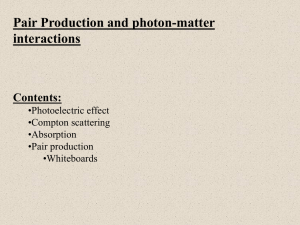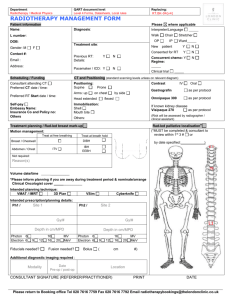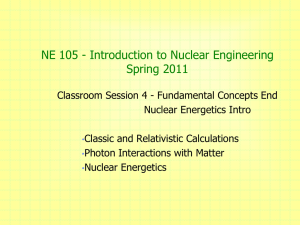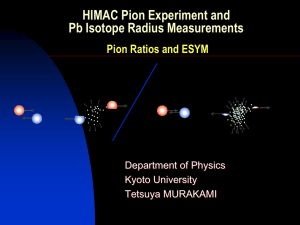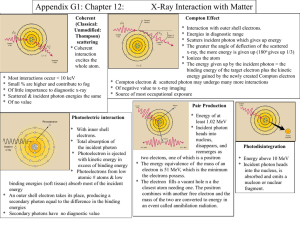mini_prop_090108
advertisement
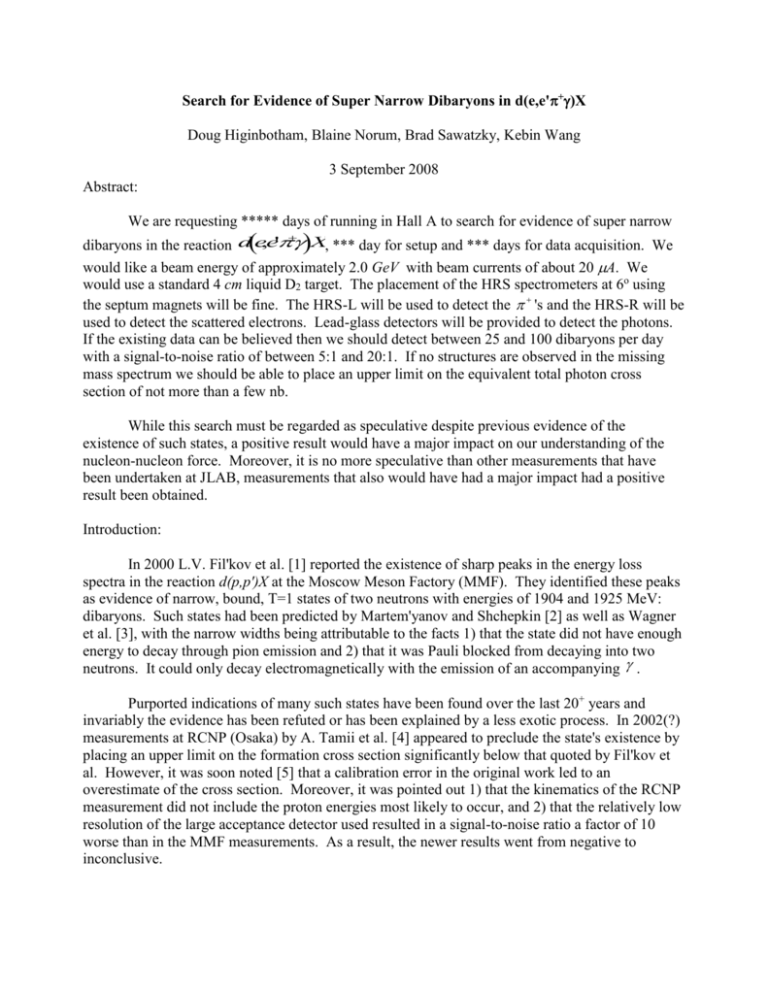
Search for Evidence of Super Narrow Dibaryons in d(e,e'+)X Doug Higinbotham, Blaine Norum, Brad Sawatzky, Kebin Wang 3 September 2008 Abstract: We are requesting ***** days of running in Hall A to search for evidence of super narrow , ' X, *** day for setup and *** days for data acquisition. We dibaryons in the reaction dee would like a beam energy of approximately 2.0 GeV with beam currents of about 20 A. We would use a standard 4 cm liquid D2 target. The placement of the HRS spectrometers at 6o using the septum magnets will be fine. The HRS-L will be used to detect the 's and the HRS-R will be used to detect the scattered electrons. Lead-glass detectors will be provided to detect the photons. If the existing data can be believed then we should detect between 25 and 100 dibaryons per day with a signal-to-noise ratio of between 5:1 and 20:1. If no structures are observed in the missing mass spectrum we should be able to place an upper limit on the equivalent total photon cross section of not more than a few nb. While this search must be regarded as speculative despite previous evidence of the existence of such states, a positive result would have a major impact on our understanding of the nucleon-nucleon force. Moreover, it is no more speculative than other measurements that have been undertaken at JLAB, measurements that also would have had a major impact had a positive result been obtained. Introduction: In 2000 L.V. Fil'kov et al. [1] reported the existence of sharp peaks in the energy loss spectra in the reaction d(p,p')X at the Moscow Meson Factory (MMF). They identified these peaks as evidence of narrow, bound, T=1 states of two neutrons with energies of 1904 and 1925 MeV: dibaryons. Such states had been predicted by Martem'yanov and Shchepkin [2] as well as Wagner et al. [3], with the narrow widths being attributable to the facts 1) that the state did not have enough energy to decay through pion emission and 2) that it was Pauli blocked from decaying into two neutrons. It could only decay electromagnetically with the emission of an accompanying . Purported indications of many such states have been found over the last 20+ years and invariably the evidence has been refuted or has been explained by a less exotic process. In 2002(?) measurements at RCNP (Osaka) by A. Tamii et al. [4] appeared to preclude the state's existence by placing an upper limit on the formation cross section significantly below that quoted by Fil'kov et al. However, it was soon noted [5] that a calibration error in the original work led to an overestimate of the cross section. Moreover, it was pointed out 1) that the kinematics of the RCNP measurement did not include the proton energies most likely to occur, and 2) that the relatively low resolution of the large acceptance detector used resulted in a signal-to-noise ratio a factor of 10 worse than in the MMF measurements. As a result, the newer results went from negative to inconclusive. From LEGS, we have data available on the photodisintegration of deuterium using polarized photons. We looked for evidence of the production of such states via the reaction: d , n ,'X where the n and ' in the square brackets were detected but their energies not determined to a usable precision. Consequently, they were not used in the subsequent analysis. [6] It was surmised that the reaction proceeded via: * d D | n n' The neutron was detected to ensure that it was a and the photon ( ' ) was detected to eliminate the huge number of events coming from quasifree production from the proton in the deuteron. We observed that when the was emitted parallel to the polarization of the two peaks were observed in the missing mass spectrum at exactly the same energies that Fil'kov et al. saw peaks (Fig 1). No peaks were observed when the came out perpendicular to the polarization. The quality of the data, particularly the energy resolution, was not adequate to support a truly definite statement. However, try as we did (changing a variety of cuts, selecting different ranges of emission angles, changing thresholds, varying the way the photon tagging data were treated, etc.), we could not make the peaks disappear. Note in figure 1 that there also appears to be congruence between peaks at about 1942 MeV in both spectra. However, the "peak" in the LEGS spectrum lies very close to the edge of the kinematic acceptance so cannot be considered reliable, very suggestive but not reliable. [Fig. 1: xxxxxx] We cannot say whether what we saw is a dibaryon, a kinematic reflection of the , a super radiant state, an N-N* molecular state, or even a statistical aberration. However, it does appear to be interesting. The implications of a dibaryon state are widespread and significant. For example, in dense nuclear matter (stellar cores, for example) the evolution of nuclear species is determined by various reaction rates and the thermodynamics of the system. Of particular importance is the distribution of energy among kinetic energy of particles, electromagnetic energy, and neutrinos. In the early stages, when the hadronic matter is dominated by nucleons and deuterons the rate at which these coalesce to form heavier elements is acutely sensitive to the kinetic energies of these particles; interaction cross sections generally rise with decreasing kinetic energy. According to our current understanding, interactions (at energies below that for pion creation) between a nucleon and a deuteron will involve either elastic scattering or deuteron disintegration. That is, all available energy is and remains in the form of hadronic kinetic energy. If a dibaryon such as that indicated by the MMF data were to exist, then * N d N ' D N ' N N would result in some of the initial hadronic kinetic energy being converted into electromagnetic energy, thus altering the thermodynamics of the system. A direct effect would be that the hadrons would be "cooled," their reaction rates increased, and the formation of heavier elements increasingly favored. Kolomeitsev and Voskersensky calculated [8] the effect of such dibaryons on the Equation of State (EOS) for neutron stars, under the assumption that the D* is a "conventional" two-nucleon bound state resulting from a "tweaked" N-N interaction. The N-D* interaction was similarly assumed to parallel the N-d interaction. They determined that within this framework the existence of such a dibaryon would prevent the formation of neutron stars having masses anywhere near the observed limit of 1.4 M. While the restrictive assumptions underlying this work prevent one from attaching too much significance to the details of their results, Kolomeitsev and Voskersensky do make the point effectively that the existence of a dibaryon would have a major impact on our understanding of such astrophysical systems. T. Walcher [9] pointed out that the purported dibaryons could be due to the existence of very light ( 20 MeV), "genuine Goldstone bosons." These could give rise to correspondingly lowenergy nucleonic excitations, N* and a low-energy dibaryon could be explained as an N-N* pairing. Evidence for such nucleonic states was found in measurements by Tatischeff et al. [12] of the , ' Xbut subsequent measurements of the reaction dp, p'pX by Fil'kov et al. reaction p pp [11] and Tamii et al. [4] yielded contradictory results. A search was performed at JLab by Jiang et , 'X. They al. [10] for confirmation/refutation of such N* states using the reaction pee determined that the cross section for the case X = N* is at least three orders of magnitude less than that for X = n. While not conclusive, their results do argue against the existence of such excited nucleons. We would like to investigate the possible existence of one or more T=1 dibaryon states further using virtual rather than real photons via the reaction: dee , '' X, where the ' is again used to suppress continuum events. For the detection of the and e' the Hall A HRS spectrometers are ideal. The potential problem is the detection of the decay 's. For the purported 1904 MeV state the decay 's will have energies of approximately 30 MeV; for the 1925 MeV state they will have energies of about 50 MeV. The question was whether we can reliably detect 's with such energies in Hall A. Our original plan was to perform a parasitic test run to answer the question by direct measurement. However, the possibility of obtaining significant beam time for an actual measurement prompted us to look more carefully at what information was currently available. We asked Pavel Degtiarenko to run his code for conditions somewhat worse than we envisioned: a 15 cm long target rather than the 4 cm long target we plan to use. Using these results we calculated expected real and accidental rates and determined that the measurement was indeed feasible. We are requesting *** days of beam time, *** for timing in the detectors and setting up the DAQ and *** for actual data taking. If the structures seen at MMF and LEGS are real and described by the theory of Martem'yanov and Shchepkin then we expect to see between 25*days and 100*days events with a signal:noise (S:N) ratio of between 5:1 and 20:1. If the observed structures turn out to be statistical artifacts then we should be able to place an upper limit on the equivalent total cross section for their photoproduction of not more than 15 #days nb. Experiment: We plan to use the existing liquid D2 target that is 4 cm long. We imposed a limit of 1105 photons per second per detector so, based on Pavel Degtairenko’s calculation, we plan to run at a luminosity of = 11037 /cm2 /s. Thus, we plan to use a beam current of about 20A. We plan to use a beam energy of 2 GeV. Of course, the spectrometers will remain with the septa in place. The HRS-R will be used to detect the scattered electrons and will be set to a momentum of 1.0 GeV/c. The HRS-L will be used to detect the and will be set to 0.95 GeV/c. This combination yields a four-momentum transfer Q2 of about 0.02 [GeV/c]2. A recoiling dibaryon will have a momentum of about 0.22 [GeV/c] at about 73o to the beam line. The low momentum of the dibaryon implies that decay photons emitted isotropically in the CoM frame will be almost isotropic in the laboratory and their energies will be little changed. For the detection of the photons we have available 68 lead glass detectors, complete with PMT's and bases, each 19.1 19.1 30.0 cm3. They were used previously in the Saskatchewan IGLOO detector. [7] We also have scintillator paddles to place in front of the PbG to veto charged particles. We plan to place 10 detectors at angles near 140o to the beam line on the left side of the scattering chamber and approximately 2 m from the target. This will give us a total photon coverage of approximately 0.1 sr. These detectors will be integrated into the standard data acquisition system. [I worry a bit about the deadtime of the scintillator veto paddles, even at back angles. Will they be OK at 140deg or will there be huge pile-up at 20 uA? Do we have data that show we can shield them enough to kill the low-energy background without degrading the gammas of interest too much?] Rates: In calculating the anticipated real event rates we started with the calculations of Martem'yanov and Shchepkin. Of particular note is the fact that phase space arguments dictate that the energy spectrum of the emitted photons is strongly peaked near the maximum possible energy. The figure below, where is the energy of the decay photon and m is the maximum energy a decay photon could have, illustrates this effect. Fig 2: xxxxxxx Real event rates were calculated two ways. In the first, we started with the photoproduction cross section calculations of Martem'yanov and Shchepkin normalized to the measurements from LEGS. We then multiplied by the appropriate virtual photon flux factor to get the expected electroproduction cross section. In the second, we used calculations provided by Lev Fil'kov. The normalization of this calculation was inferred from the results of the d(p,p')X results. These calculations included a small longitudinal contribution which was necessarily not present in the first calculation. Nevertheless, the former calculations yielded high cross sections. Given that the first calculation was normalized to electromagnetic reaction data we tend to give it greater credence. Under the assumption of *** days of running we project, based on the calculation normalized to the LEGS data, a total of about 100*days events or, based on the calculation normalized to the d(p,p')X data, about 25*days events. In estimating the rate of accidental coincidences we started with Pavel Degtiarenko’s (PD’s) calculations. We then assumed a timing resolution of 2 ns and a missing mass resolution of 2 MeV. Since the width of any dibaryon peak is expected to be dominated by this width it was used in calculating the signal-to-noise ratio. PD’s calculations gave an electron singles rate in the HRS-R ( = 0.006 msr, E = 100 MeV) of about 1105/s. This number was very difficult to extract from his results so, to be safe, we assumed a rate of 5105/s. His calculations gave a pion rate in the HRS-L ( = 0.006 msr, p E 100 MeV) of about 3104/s. These combine to give an accidental double coincidence rate of 5 4 9 R R R 5 1 0 / s 3 1 0 / s 2 1 0 s 3 0 / s . A , 2 E c o i n To this we added a rate of 20/s for “real” pion double coincidences for these acceptances obtained from the MAINZ2003 web page. Here we assumed that the cross section for + production from the deuteron was equal to that from the proton and that the Fermi smearing would spread the pions over the HRS-L acceptance roughly uniformly. Thus we obtained a total e- double coincidence rate of 50/s. The missing mass corresponding to these coincidences spread over about 200 MeV so only 1% would have missing masses beneath a particular dibaryon peak. And, the bulk of the 106/s photon rate would be spread over about 100 MeV whereas the majority of those associated with a dibaryon would most likely have energies within about 5 MeV of the maximum possible. Consequently, the rate of “valid” accidental triple coincidences lying under a dibaryon peak would be 21 M e V 0 M e V 6 9 4 R R R 1 1 0 / s 2 1 0 s 1 1 0 / s A , 3, A 2 e ' 2 0 0 M e V 1 0 0 M e V or about 10 per day. Thus, we anticipate a signal-to-noise ratio of between 5:1 and 20:1. Conclusion: We anticipate that in a ***** day run (*** for setup, *** for data acquisition) a very clear indication can be obtained as to whether the suggested super narrow dibaryon states actually exist. If they do exist and have a production cross section similar to that suggested by previous data then we should be able to extract a (model-dependent) cross section for electroproduction with a precision of about 10%. Alternatively, if no structures are observed we should be able to place an upper limit of the order of a few nb on the corresponding photoproduction cross section. This experiment is speculative. The data shown are very suggestive but not conclusive. However, given the extremely broad impact a positive result would have we believe that a search for definitive evidence of such states is very well justified. References: [1] L.V. Fil'kov et al., Phys. Rev. C61 (2000) 044004. [2] B.V. Martem'yanov and M.G. Shchepkin, JETP Lett. 53 (1991) 139. [3] G. Wagner et al., Nucl. Phys. A594 (1995) 263. [4] A. Tamii et al., Phys. Rev. C65 (2002) 047001. [5] L.V. Fil'kov, arXiv:nucl-th/0307076 v2 12 August 2003. [6] A. Cichocki, "Search for Super Narrow Dibaryons," PhD Dissertation, University of Virginia, May 2003. [7] J.M. Vogt et al., Nucl. Instrum. Meth. in Phys. Res. A366 (1995) 100. [8] E.E. Kolomeitsev and D.N. Voskresensky, Phys. Rev. C65 (2002) 015805. [9] T. Walcher, hep-ph/0111279. [10] X. Jiang et al., Phys. Rev. C67 (2003) 028201. [11] L.V. Fil'kov et al., Eur. Phys. J. A12 (2001) 369. [12] B. Tatischeff et al., Phys. Rev. Lett. 79 (1997) 601; ibid, 81 (1998) 1347; Eur. Phys. J. A17 (2003) 245.

